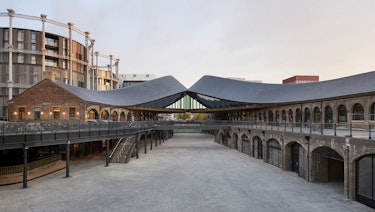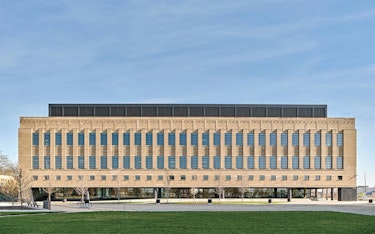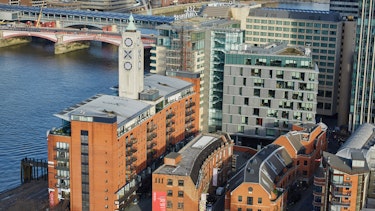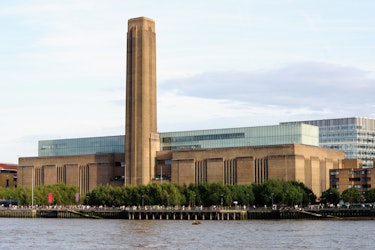In our dynamic world where urban landscapes are in a perpetual state of transformation, the concept of adaptive reuse stands as a beacon of sustainability and architectural ingenuity. Adaptive reuse projects involve the transformation of existing structures, often historic buildings, into new spaces that cater to the needs of modern society. These projects are driven by the imperative to prioritize flexibility for the future. They breathe new life into old structures while simultaneously preserving their cultural and architectural heritage. This article delves deep into the profound significance of adaptive reuse, explores its myriad sustainability benefits, and underscores the pivotal role it plays in the context of urban renewal. Moreover, we emphasize the importance of architectural innovation in ensuring the long-term success of these transformative projects.

Credit: Architectural Record
The Essence of Adaptive Reuse
Adaptive reuse, also known as building recycling or repurposing, is the innovative process of reinvigorating an existing building or structure for a new and often entirely different purpose than its original intent. This approach stands in stark contrast to the conventional practice of demolishing old buildings to make way for new construction, a process that consumes substantial resources and contributes to environmental waste. Adaptive reuse not only conserves valuable resources but also honours the cultural, historical, and architectural legacy of a community.
Historic buildings often take centre stage in adaptive reuse projects. These structures are living artifacts that narrate the tales of the past, bearing within them the essence of their time and place. By repurposing these buildings, architects and developers can create spaces that are both functional and imbued with historical significance. Whether it's transforming an old factory into contemporary loft apartments, converting a historic school into a vibrant community centre, or breathing new life into a disused warehouse as a thriving art gallery, adaptive reuse celebrates the inherent beauty of existing structures and their potential for transformation.

Credit: Rethinking The Future
Sustainability at Its Core
One of the primary driving forces behind the surge in adaptive reuse projects is sustainability. In an era marked by profound environmental challenges and a concerted global effort to reduce carbon footprints, repurposing existing structures has emerged as a commendable and sustainable alternative to new construction. Several key sustainability benefits of adaptive reuse merit our attention:
Resource Conservation: Adaptive reuse drastically reduces the demand for new building materials, thus preserving precious natural resources like timber, steel, and concrete. This, in turn, leads to a reduction in energy consumption associated with the production and transportation of these materials.
Energy Efficiency: Older buildings often boast solid foundations and durable materials, making them inherently energy efficient. Retrofitting these structures with modern energy-efficient technologies further enhances their environmental performance.
Minimized Construction Waste: Adaptive reuse projects generate significantly less construction waste compared to new construction. This practice not only minimizes the disposal of construction debris in landfills but also curtails the need for fresh construction materials.
Lower Carbon Emissions: The construction industry is a major contributor to greenhouse gas emissions. By repurposing existing buildings, adaptive reuse projects emit fewer greenhouse gases compared to constructing new buildings from scratch.
Preservation of Green Spaces: Adaptive reuse promotes the reuse of urban spaces, thereby helping to preserve green areas and mitigate the adverse effects of urban sprawl, which often leads to the destruction of natural habitats.

Credit: Metropolis
Urban Renewal and Community Revitalization
Adaptive reuse projects play an instrumental role in the larger context of urban renewal and community revitalization. Many cities across the globe grapple with the challenge of rejuvenating their aging neighbourhoods and industrial areas. These spaces often possess untapped potential, and adaptive reuse represents a sustainable avenue to breathe fresh vitality into them.
Economic Development: The repurposing of historic buildings can attract new businesses, residents, and tourists to an area, thereby catalysing economic growth. When complemented by supportive policies and incentives, adaptive reuse projects become pivotal drivers of job creation and economic rejuvenation.
Cultural Preservation: The preservation of historic structures through adaptive reuse helps maintain a city's cultural identity. It allows communities to safeguard their heritage and traditions while embracing the opportunities of modernity.
Mixed-Use Spaces: Adaptive reuse projects often culminate in mixed-use developments where commercial spaces harmoniously coexist with residential units. This dynamic creates vibrant, walkable neighbourhoods that foster social interaction and community engagement.
Blight Mitigation and Crime Reduction: Abandoned or neglected buildings can become eyesores and breeding grounds for criminal activity. Adaptive reuse projects metamorphose these spaces into community assets, effectively reducing urban blight and enhancing public safety.
Infrastructure Enhancement: Adaptive reuse projects can catalyse infrastructure improvements in the surrounding area. This might include enhanced transportation options, upgraded utilities, and improved public spaces, all of which contribute to the holistic development of an urban locale.

Credit: San Antonio Report
The Role of Architectural Innovation
The triumphant execution of adaptive reuse projects is intrinsically tied to architectural innovation. Architects and designers engaged in these endeavours confront a unique set of challenges, including dealing with outdated infrastructure, complying with contemporary building codes, and meeting the ever-evolving needs of users. However, these challenges simultaneously present exciting opportunities for creative solutions.
Synergy of Old and New: One of the most captivating aspects of adaptive reuse projects is the seamless integration of historical elements with contemporary design. Architectural innovation facilitates the harmonious coexistence of modern amenities while preserving the intrinsic character of the original structure.
Sustainable Design Practices: Architects can infuse sustainable design principles into adaptive reuse projects, encompassing passive solar design, efficient insulation, and the incorporation of renewable energy sources. These sustainable practices augment the environmental performance of repurposed buildings.
Flexibility in Design: The adaptability of repurposed spaces is paramount. Architectural innovation ensures that layouts and systems are designed with flexibility in mind, allowing for easy modification to accommodate changing needs and future uses.
Preservation Expertise: Architects working on adaptive reuse projects often collaborate closely with preservationists who specialize in historic buildings. This synergy ensures that the building's historical integrity is preserved while simultaneously meeting contemporary requirements.
Community Engagement: Architects have a unique opportunity to engage with the local community, soliciting their input to understand their needs and aspirations for the repurposed space. This community engagement-driven approach informs the design process, yielding spaces that genuinely serve the community.

Credit: Dezeen
Case Studies in Adaptive Reuse
To vividly illustrate the transformative potential of adaptive reuse, let us delve into several noteworthy case studies:
The High Line, New York City: The High Line is an urban park ingeniously built on a disused elevated railway track. This transformative project metamorphosed an obsolete industrial structure into a thriving green space that now stands as an iconic symbol of urban renewal in the heart of Manhattan.
Tate Modern, London: The Tate Modern, one of the world's foremost contemporary art museums, found its home in what was once the Bankside Power Station. The adaptive reuse of this industrial marvel preserved its iconic chimney stacks while providing an ideal environment for the exhibition of art in its various forms.
The Pearl Brewery, San Antonio: The Pearl Brewery is a resplendent example of a formerly derelict industrial site transformed into a vibrant mixed-use development, replete with shops, restaurants, apartments, and a hotel. This transformative project not only revitalized the surrounding neighbourhood but also became a cultural epicentre for the city.
The Silo Hotel, Cape Town: The Silo Hotel, a luxury establishment, resides within a historic grain silo complex. By ingeniously integrating modern design elements with the building's industrial heritage, the hotel offers guests a truly unique and visually striking experience.
Oxo Tower Wharf, London: The Oxo Tower, originally a power station and warehouse, now houses a dynamic ensemble of restaurants, shops, galleries, and residential apartments. The adaptive reuse of this iconic structure preserved the Oxo Tower signage while rejuvenating a significant portion of London's vibrant South Bank.

Credit: AR
Adaptive reuse projects stand as exemplars of urban sustainability and architectural innovation, placing flexibility for the future at their core. These projects not only offer sustainable solutions to the challenges of urban development and historic preservation but also honor the intrinsic character of existing structures. In an era defined by rapid urbanization and pressing environmental concerns, adaptive reuse projects showcase a path forward. They embody a harmonious marriage of the past and the present, infusing new life into old buildings and redefining urban landscapes in ways that are both meaningful and sustainable. As we collectively strive for a more sustainable and resilient future, the transformative power of adaptive reuse remains a beacon of hope and inspiration.
.jpg?ixlib=gatsbyFP&auto=compress%2Cformat&fit=max&q=75&w=375)